![]()
![]()
![]()
Use LEFT and RIGHT arrow keys to navigate between flashcards;
Use UP and DOWN arrow keys to flip the card;
H to show hint;
A reads text to speech;
50 Cards in this Set
- Front
- Back
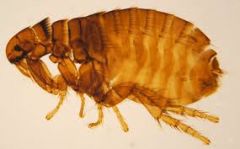
Dog Flea |
Ctenocephalides canis- DogFlea Size of adult: 3-4mm. Life cycle is variable.Size of egg:0.5mm.Importance:Infests in dogs and cats (C. felis). Fleabite, dermatitis, anemia, vector for Dipylidium caninum, tularemia, plague, etc. Adult fleasinfest mammals transiently. Eggs, larvae, and pupae are in the environment. Diagnosis: By observing fleas on pet. Fleafeces (pepper). When wet should leach out pink (undigested blood). Watch forcontinuous scratching and chewing of inflamed skin, specially in inguinal,axillary areas and base of the tail can indicate their presence. Some dogssuffer from flea allergic dermatitis (FAD), where the inflammatory cycle can beset off by a single flea bite. * Life cycles vary from 16 days (idealconditions) to 120 days (unsustainable environment). Pupa can over-winter.Average life span of the adult is 4-21 days. Treatment: Fipronil (Frontline) for adult fleas,ticks and some mites and lice. Imidocloprid(Advantage) for adult fleas and some lice. Nitenpyram (Capstar) for adult fleas only, Selamectin (Revolution) for adult fleas, flea eggs, ear mites,sarcoptic mange, and some ticks. Note: treat host and the environment. Fleasdie when held below -6.6C for 48 hours or at 48C (dry heat) for several days. |
|
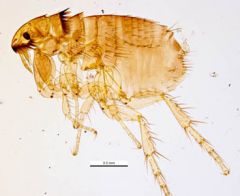
Cat/Guinea Pig Flea |
Ctenocephalides felis- Same description, importance, diagnosis, treatment, life cycle as C. canis. Differences are in the genal comb, pronotal comb and shape of the head between C. canis and C. felis. |
|
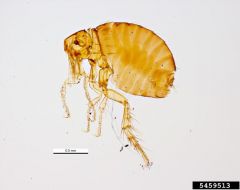
Sticktight flea |
Echidnophagagallinacea- “sticktight flea” * found mostly on birds, can alsoinfest dogs and cats · About ½ the size of C. canis or C. felis. · Will be found in eyelids andear canals · Hang on like a tick and willremain in clusters if left undisturbed. · Has no genal or pronotalcomb ,with an angular head. · Buries mouthparts into skin andstays in one place for day/weeks · Irritation and blood loss · May cause anemia and death,especially in young birds· Treatment: Topical pyrethrin. |
|
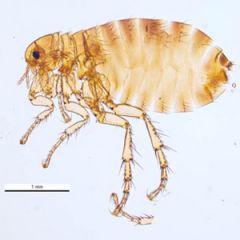
Human and Guinea Pig Flea |
Pulex irritans (No genital or prenotal combs) |
|

Digger flea (human and pig flea) |
Tunga penetrans- Diggerflea · Parasite of humans and pigs · Angular head with no comb ofspines · Thoracic segments are verynarrow at the top · Adult female burrows into theskin of the host · Permanently inhabits thecutaneous or subcutaneous tissues · Clinical signs include extremeitching, pain, inflammation and secondary infections. · Surgical removal of the fleasis usually required. |
|
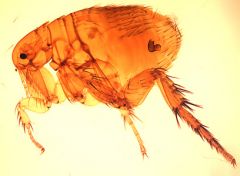
Oriental Rat Flea |
Xenopsylla cheopis-oriental rat flea- VECTOR FOR PLAGUE |
|
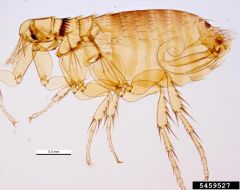
Northern Rat Flea |
Nosopsyllus fasciatus- northernrat flea |
|
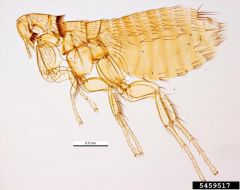
Mouse flea |
Leptopsylla segnis- Mouseflea |
|
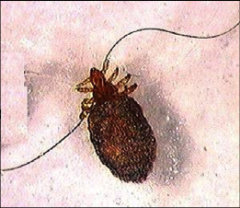
Dog sucking louse (Anoplura) |
Linognathus setosus- Sucking louse of dogsSize of adult: 2-3mm. Life cycle is 3weeksImportance: Causes skin irritation,itching, dermatitis, alopecia, anemia, roughened hair coat. Diagnosis: Examine hair for adults,nymphs, eggs (nits). Narrow head with piercing mouthparts. Front legs havelarge claws, pincers for hanging on. Slow moving. Treatment: Carbaryl, ivermectin. |
|
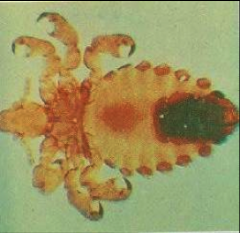
Horse Louse ( Anoplura) |
Haemotopinus asini- Horse louse |
|
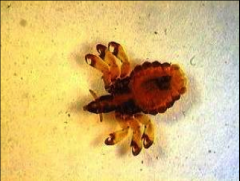
Hog Louse (Anoplura) |
Haematopinus suis- Hog louse(Insecta-Anoplura) Size of adult: 5-7mm. Life cycle 3-4 weeksImportance: Irritation, anemia, may transmit Eperythrozoan suis(richettzia). Diagnosis: Examination of skin for adult eggs, nyphs and adult lice. Treatment: Amitraz, Ivermectin and a lot of other treatments |
|
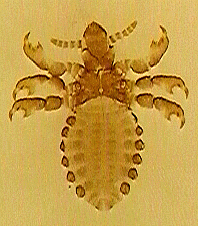
Short nosed Cattle Louse (Anoplura) |
Haematopunus eurysternus- Short nosed cattle louse |
|
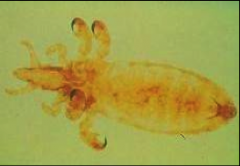
Long Nose Cattle Louse (Anoplura) |
Linognathus vituli- Long nosed cattle louse |
|

Sheep face and body louse (Anoplura) |
Linognathus ovillus- Sheep face and body louse |
|
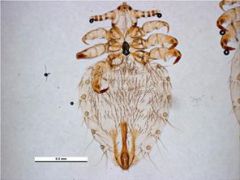
Sheep Foot Louse (Anoplura) |
Linognathus pedalis- Sheep foot louse |
|
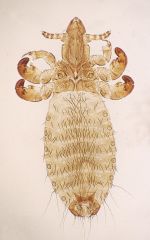
Goat Sucking Louse (Anoplura) |
Linognathus stenopsis- Goat sucking louse |
|
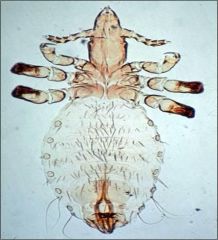
Sucking Lice (Anoplura) |
Linognathus sp. – Sucking lice(Insecta-Anoplura) Size of adult- 2.5-5.0mm Importance: Casues irritation and weight loss; may cause anemia. Diagnosis: Primarily found on the legs. Affected animals lick,scratch, and bite-affected areas. Treatment: Various types of treatment. All animals must be treatedsimultaneously. |
|
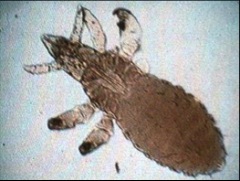
Little Blue Cattle Louse (Anoplura) |
Solenoptes capillatus- little blue cattle louse |
|

Sucking lice of Mice and Rats (Anoplura) |
Lolyplax spp- Sucking lice of mice and rats |
|
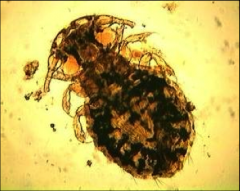
Bitting Louse of Dogs (Mallophaga) |
Trichodectes canis- Biting louse of dogs(Mallophaga) Size of adult: 2-4mm. Life cycle of 3weeksImportance: Causes roughened hair coat,itching, dermatitis. May act as intermediate host for Dipylidium caninum. Diagnosis: examination of the hair foradults, nymphs and nits. Treatment: Carbaryl |
|
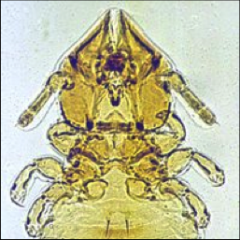
Bitting Louse of Cats (Mallophaga) |
Felicola subrostratus- Biting louse ofcats (Mallophaga) Size of adult: Similar to Trichodectes canis. Importance: Very uncommon. Samelifecycle as Trichodectes canis. Headshaped more like a wedge. Note: All biting lice havesimilar morphology- large broad head, fast moving. |
|
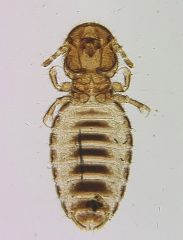
Bitting Lice (Mallophaga) |
Damalinia spp- Biting lice Size of adult- 2-4mm Importance: Common in lamas, horses, cattle and sheep. Causesitching, restlessness, hair loss, and poor growth. Diagnosis: Direct observation of hair, specially along dorsalmidline and rump. Examining with a flashlight is helpful. Treatment: Treat all animals simultaneously. Ivermectin type products |
|

Horse Louse (Mallophaga) |
Damalinia equi- Horse louse |
|
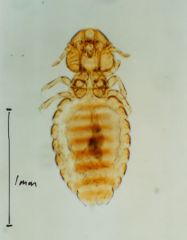
Cattle Louse (Mallphaga) |
Damalinia bovis- Cattle Louse |
|
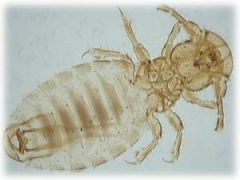
Sheep Louse- (Mallophaga) |
Damalinia ovis- Sheep louse |
|
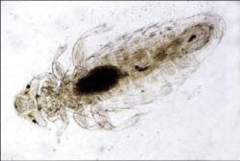
Avian Bitting Louse- (Mallophaga) |
Menopon spp- Avian biting lice Size of adult: 2-4mm Importance: Irritant, may be debilitatingDiagnosis: Observation of adults, nymphs and nits Treatment/Control: carbaryl. Note: there are no bitinglice for mice and rats. |
|
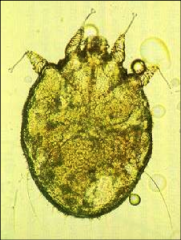
Scabies Mite (Sarcoptidae) |
Sarcoptes scabiei- Scabiesmite (sarcoptic mange) Adult size: 400-600um. Adults, nymphs,larvae (6 legs), and eggs are in the skin Importance:Cause severe itching, thickened skin, alopecia, although some animals may becarriers with few clinical signs. Zoonotic.Not host specific but will have host specific strains: ie: caninestrain will infect other species (humans) but will not complete life cyclethere. Causes transient dermatitis and pruritus, but it is self limiting. (2 weeks). Rare in cats. Deep burrowing andlays eggs under the skin. Round in shape. Short back legs which do not extendpast the body. Front pedicles are long, unjointed with sucker cups on the ends.Usually starts at the head and ear margins then spreads. Diagnosis:Deep skin scrapings at the margins of the lesion. Treat based on clinical signsand history. Treatment: Ivermectin- SQ inj. Once/week for 3 weeks;Selamectin topical. |
|
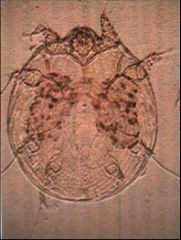
Mange Mite (Sarcoptidae) |
Notoedres cati- Mange mite (Sarcoptidae)Size of adult: 300-400um. Life cycle is 17 daysImportance:Persistent pruritis and alopecia on face, ears and neck. Zoonotic. Humans develop pruritic papular rash. Diagnosis:Moderatelly long pedicle (not as long as Sarcoptesspp), unjointed. Very similar in appearance to Sarcoptes but almost perfectly round. Deep skin scrapings at themargins of the lesion. Treat based on clinical signs and history. Treatment: Ivermectin (same as Sarcoptes). Notoedres musculi- Mice Notoedres muris- Rats,Guinea pigs- Ear mange mite, burrowing mite. Notoedres sp- Hamsters |
|

Follicular Mange Mite, Demodectic Mange, Demodecosis (Demodecidae) |
Demodex canis- Follicular mange mite Size of adult: 200-300um. Life cycle is approx. 21 days Importance: Rare in cats. Host specific.Bilateral, symmetrical alopecia, especially eyebrows, lips, most pronounced overbony prominences. Pyoderma, pruritus. Most common in younger dogs (under 1y/o).Most frequently in pigs, rare in horses. Usually asociated with long-termsteroid therapy which lowers the animals immune response. Diagnosis:Cigar-shapped, 8 legs at the anteriro end. Squeeze/pinch the skin at the edgeof the lesion then perform a deep skin scraping. Report: # seen, Stagesobserved, are they alive? (specially when tx has begun) Treatment: Ivermectin, although self-resolving ifsource of stress is removed. Rarely treated in horses since AMITRAZ(the only really effective treatment) is contraindicated in horses-produces severe colic and death. Demodex musculi- Mice Demodex cavae- Guinea Pig Demodex sp- Hamsters |
|
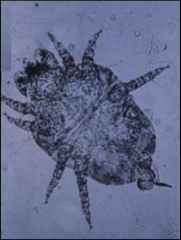
Fur Mite of Dogs and Cats, Walking Dandruff (Cheyleridae) |
Cheyletiella spp- Fur mite of dogs andcats, walking drandruff (Cheyleridae) C. yasguri- Dogs C. blakei- Cats C. parasitivorax- rabbits Size of adult: 300-500um. Life cycle is 18-21 daysImportance:Mild alopecia and pruritus; many animals are asymptomatic; Zoonotic: may cause dermatitis in humans. Inhabits the skinsurface. Diagnosis: Distinctive large hookedmouthparts, very slow moving. Superficial skin scrapings; usually observedmoving within the hair coat or amongst the dander that is brushed off.Treatment: Carbadyl, dichlorvos collars, Ivermectin. |
|

Ear Mite of Dogs and Cats (Psoroptidae) |
Otodectes cynotis- Ear mite of dogs andcats (Psoroptidae) Size of adult: 500-800um. Life cycle 18-21 daysImportance:Intense pruritus or ear canal which may be followed by self-mutulation, otitismedia, and bacterial infection. Diagnosis:Very short, unjointed pedicle. Ear debris will be black, reasonably dry andcrusty as opposed to waxy. Ear swab- use mineral oil on the slide, observeadult mites as well as eggs under 4x power. Treatment: Milbemycin, Ivermectin, selamectin. |
|
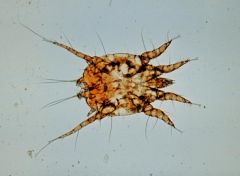
Horse Scale and Wet Mange Mite (Arachnida- Psoroptidae) |
Psoroptes equi- Horsescale and wet mange mite Adult size: 500um (male), 700um (female)Importance: Psoroptes sp. Thisis a reportable disesase in cattle and sheep in some states. It is verycontagious and highly pathogenic, causing dramatic weight loss. Mites punctureskin and cause inflammation and hair loss. Affected animals bite, scratch. Inhoses (P. equi) papules discretesmall bumps in the skin) are seen, as well as alopecia and thick hemorrhagiccrusty lesions. Primarily found in thick hair regions of the body. Diagnosis: skin scrapings at the peripheryof the crusty lesion. Mites have long and pinty pedicles.Treatment: Ivermectin. |
|
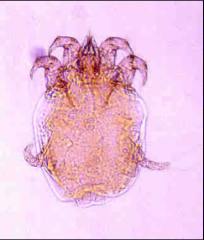
Mange Mite or Scab Mite of Horses, sheep, goats (and rabbits)- Ear mites. |
Psoroptes cuniculi- Horses,sheep, goats (and rabbits)- ear mites * Pruritic otitis externa; headshaking is common. * Recovery is by skin scrapings- easier to recover than Sarcoptes spp. * Treatment is the same as forSarcoptic mange. * Can spread to the body- bigproblem in Angora goats- damage to hair coat. |
|

Mange Mite of Cattle, sheep, goats (Arachnida-Psoroptidae) |
Chorioptes sp.- Mange miteof cattle, sheep, goats (Arachnida-Psoroptidae) Adult size: 250um (male), 600um (female)Importance: This is a reportable disease incattle in some states. Not as pathogenic as Psoroptesor Sarcoptes. Causes tail andfoot mange. · Horses- (C. equi, . bovis) · Cattle and sheep- (C. bovis, C. ovis) · Goats- (C. caprae) Diagnosis: Papules seen, followed byalopecia, crusting and thickening of the skin. Moist dermatitis of the fetlockin chronic areas. Skin scrapings. Mites have very short and unjointed pedicles. Treatment: Ivermectin |
|
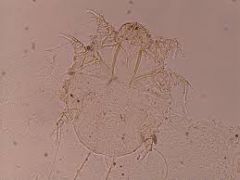
Bird Leg and Face Mite |
Cnemidocoptes (Knemidocoptes) mutans- Bird Leg and face mites Size of adult: 400um Importance: Burrow under the scales of feetand legs, specially in old chickens. Crusting and deformity leading to lamenessand secondary infections. Uncommon in commercial facilities. Transmitted bydirect contact. Spends entire life cycle on the host. K. gallinae (Neocnemidocoptes gallinae)- Depluming mite- · Effects are at feather base- pruritus and feather plucking. · Isolate affected birds- treat with Ivermectin.K. pilae- scaly face mite-mostly caged birds, exotics · Most common in chickens and psitticines · Face, beak, legs and feed · Can damage the epidermal cells which form the beak resulting indeformities. |
|
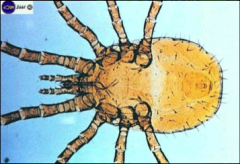
Feather Mite, Red Mite, Roost Mite |
Dermanyssus gallinae- Feathermites, red mite, roost mite. Size of adult: 1mm Importance: Pruritis, decreased production,debilitation, anemia. Diagnosis: Observation of mites (adults,nymphs, larvae, eggs) in feathers. Night observation is best. Life cycle is9-12 days. Reddish in colour. Oval body, long and narrow mouthparts. Short,unjointed pedicles. Infests chickens, turkeys, pigeons, canaries and variouswild birds. Transmission by direct contact or by transportation on otherobjects- cages, boxes, feeders, people. Treatment: Treat host and environment. If using spray ons must ensure itpenetrates the feathers at the vent. |
|
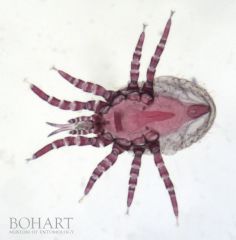
Northern Fowl Mite |
Ornithonyssus sylvarium- Northernfowl mite· similar to Dermanyssus- Longand narrow· Thicker hairs on abdomen · Most important parasite of caged layers and breeding chickens in theUSA · Can infect many species of birds, rats, mice, and man but cancomplete its cycle on birds · Bloodsucking- spend their entire life cycle (1 week) on host · Diagnosis: Adults, eggs and feces observed on skin when feathersparted; lesions on skin; adult mites may be seen on eggs · Treatment: Control methods and treatment same as D. gallinae. |
|

Spinose Ear Tick |
Otobius megnini- Spinoseear tick Importance: lives near ear canal. Infests mostwarm-blooded animals. This is the only soft tick of major importance. Leatherybody. Mouthparts are hidden when viewed from dorsal aspect. |
|
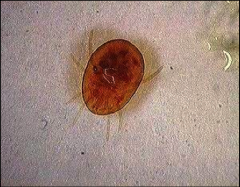
Avian Soft Tick (Arachnida- Argasidae) |
Argas persicus- Avian soft tick(Arachnida-Argasidae) Size of adult: 7x5mm Importance: Decreased production, anxiety,anemia, vector for fowl spirochaetosis.Diagnosis: Soft ticks on birds feed atnight or in environment. Birds become afraid to go back into the chicken houseat night. Life cycle 1 month. Yellowish/brown if unfed- bluish tinge whenengorged. Treatment: Treat host and environment. |
|
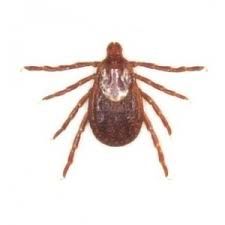
Seed and Larval Tick |
Dermacentor spp. |
|

Tick Species |
Ixodes spp. |
|
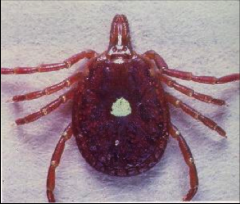
Brown Dog Tick |
Rhipicephalus sanguineus (Browndog tick)Adult size: 700x500um (6 legs) Importance: May cause anemia, paralysis ifinfestation is heavy. May be responsible for tranmission of diseases( Babesia spp, Erluchia spp- blood parasites). Mainly an irritant. Causes RockyMountain Spotted Fever, Coon Hound paralysis. Borrelia dergdorferi (Lyme disease). Diagnosis: Hard chitinous shell. Mouthpartsusually visible from the dorsal aspect. Treatment: Removal. Numerous compounds suchas fipronil, dichlorvos, organophosphates (environmental), selemectin (certaingenera). |
|
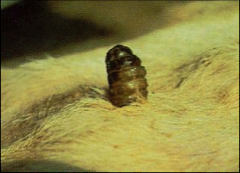
Cattle grubs, Warbles |
Hypoderma spp. Cattle grubs, warbles. H. lineatum, H. bovis- (Insecta-Diptera) Size of larvae: (grubs) up to 30mm Importance: Larvae migrate through flesh and cause a reduction inweight gain and value of hides. Migrate to esophagus (H. lineatum) or spinal column (H.bovis) before forming warbles on the back. Diagnosis: Usually dirty white when theyemerge from skin. Very thick, barrel-shaped. Segmented larva, short spines oneach segment. Third-stage larvae from warbles on the back of cattle. Alsooccasionally on bison, horses, sheep, and goats. Diagnosed by the presence ofbumps under the skin. Treatment: Pour-on organophosphates.Ivermectin. |
|
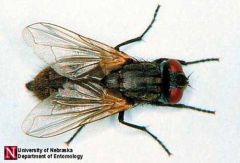
House Flt (Insecta- Diptera) |
Musca domestica- House fly(Insecta- Diptera) Adult size: 5-12mm Importance: Irritate cattle, cause reducedweight gains and loss of production. This is the only fly of importance inpigs. Diagnosis: identification of flies. Prevention: Sanitation; feed larvaecidaldrugs. |
|
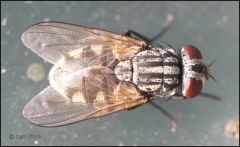
Face Fly (Insecta-Diptera) |
Musca autumnalis- face fly(Insecta- Diptera)Adult size: 6-9mm Importance: Irritate eyes and nostrils, maypredispose to bacterial keratoconjunctivitis “pink-eye”, transmit eyeworms (Thelazia spp.), and infectious bovinerhinotracheitis. This is a non-biting fly (spongy mouthparts). They followbiting flies and drink the blood as it pools after the biter is chased away. Diagnosis: Identification of flies |
|
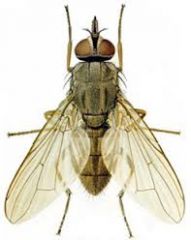
Cattle Horn Fly (Insecta- Diptera) |
Siphona (Haemotobia irritans)-Cattlehorn fly (Insecta- Diptera) Adult size: 4-5mm Importance: Irritate cattle; occur in largenumbers and cause weight and blood loss, and reduce production. Diagnosis: Identification of adult fly.Size is smaller than house fly. Usually feed with head down. Sharp proboscis.Adults spend their entire life on the host, females leave to lay eggs on freshcow feces then return. Prevention: Ivermectin kills larvae in manure. |
|
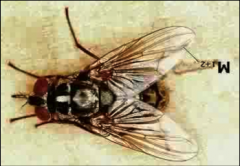
Stable Fly (Insecta- Diptera) |
Stomoxys calcitrans- Stable fly(Insecta-Diptera) Adult size: 7-8mm Importance: Persistant blood-suckin flies thatbite and irritate cattle; caused reduced weight gains and reduced feedefficiency. Sharp proboscis. Does not stay on host for long. Usually attacksthe legs and ventral abdomen. Vector forequine infectious anaemia and the intermediate host for Habronema muscae. Diagnosis: Identification of adult fly.Size of a house fly, but proboscis is very prominent.Prevention: Flies breed on rottingvegetation; therefore sanitation is helpful. |
|
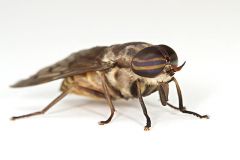
Horse Fly (Insecta- Diptera) |
Tabanus spp. – Horse fly(Insecta- Diptera)Adult size: Up to 30mm Importance: Viscious biters, causingstampeding and reduction of weight gain. Transmit anaplasmosis. Blood feeders (female only)Diagnosis: Identified by large head andscisor-like lacerating mouthparts. Treatment: Control is difficult as they donot spend much time on the animals. Chryops spp- Deer fly-smaller then horse fly. |
|
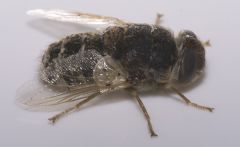
Sheep Nasal Bot Fly (Insecta- Diptera) |
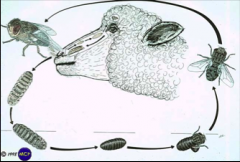
Oestrus ovis- Sheep nasalbot fly (Insecta- Diptera) Larvae size: Larvae up to 15mm Importance: Causes nasal discharge anddifficulty breathing. Adult flies frighten sheep and predispose to reducedproduction. Adult deposits larvae into nostrils of sheep. Does not have toland. Larva migrate to nasal passages. Larvae can burrow into brain Diagnosis: Clinical signs, observe larvaeat necropsy. Treatment: Ivermectin. |
|
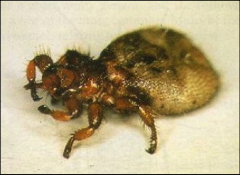
Sheep Ked- Wingless Fly-Sheep "tick" (Insecta- Diptera) |
Melophagus ovinus- Sheep ked (Insecta-Diptera) Adult size: 5-8mm. Life cycle about 3months. Importance: Causes irritation, lesions tothe skin (cockle), anemia, wool loss, and reduction in weight gain. Spendsentire life on host. Looks like a wingless fly Diagnosis: Visual observation of wool forpupae and adults. Treatment: Spray applications of trichlorphon (among many), Ivermectin. |

